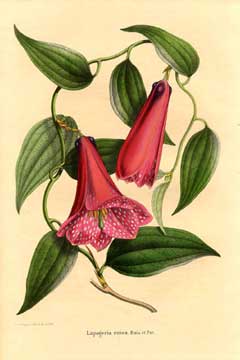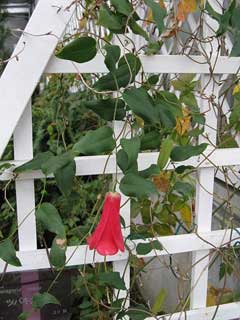 |
|
http://commons.wikimedia.org/wiki/File:Liliaceae_Lapageria_rosea_1.jpg |
 |
| http://commons.wikimedia.org/wiki/User:KENPEI |
Translate this page:
Summary
Physical Characteristics

 Lapageria_rosea is an evergreen Climber growing to 5 m (16ft) by 5 m (16ft) at a medium rate.
Lapageria_rosea is an evergreen Climber growing to 5 m (16ft) by 5 m (16ft) at a medium rate.
See above for USDA hardiness. It is hardy to UK zone 9. It is in leaf all year, in flower from July to December, and the seeds ripen from September to October. The species is hermaphrodite (has both male and female organs) and is pollinated by Insects.
Suitable for: light (sandy), medium (loamy) and heavy (clay) soils and prefers well-drained soil. Suitable pH: mildly acid and neutral soils. It can grow in full shade (deep woodland) or semi-shade (light woodland). It prefers dry or moist soil.
UK Hardiness Map
US Hardiness Map
Synonyms
Plant Habitats
Edible Uses
Fruit - raw or cooked[2, 139, 163, 177, 200]. A sweet white juicy pulp, the yellow fruits are the size of a hen's egg[183].
References More on Edible Uses
Medicinal Uses
Plants For A Future can not take any responsibility for any adverse effects from the use of plants. Always seek advice from a professional before using a plant medicinally.
None known
References More on Medicinal Uses
The Bookshop: Edible Plant Books
Our Latest books on Perennial Plants For Food Forests and Permaculture Gardens in paperback or digital formats.

Edible Tropical Plants
Food Forest Plants for Hotter Conditions: 250+ Plants For Tropical Food Forests & Permaculture Gardens.
More

Edible Temperate Plants
Plants for Your Food Forest: 500 Plants for Temperate Food Forests & Permaculture Gardens.
More

More Books
PFAF have eight books available in paperback and digital formats. Browse the shop for more information.
Shop Now
Other Uses
References More on Other Uses
Cultivation details
Thrives in a lime-free humus-rich soil[49, 182, 200]. Requires a cool shady position in a warm moist atmosphere[182]. Succeeds in dry shade according to another report[188]. Requires a deep open-textured soil in a warm position[11, 133, 200] with shade[49, 120]. Requires a well-drained soil[1, 133, 200]. Dislikes cold winds[163]. The Chilean bellflower is best grown on a partially shady and sheltered wall where it will withstand temperatures down to about -5°c[200]. Plants on sunny walls tend to succumb in cold winters whilst those on shady walls are much more likely to survive[120]. Plants can be cut back to the ground in cold winters but will often regrow in the spring[120]. A climbing plant that supports itself by twining around other plants and other supports[219]. It does not really require pruning[219]. A very ornamental plant[1], it is the national flower of Chile[183]. It is not very cold-tolerant, but is commonly cultivated in greenhouses in Britain. It is, however, hardy outdoors in the milder areas of the country[1, 182]. The fruits are only occasionally formed in Britain[219]. When growing this plant from seed, it pays to be very selective and only grow on the strongest seedlings since a weak plant tends to remain weak[1]. Slugs are very fond of the young plants and will soon destroy them if given an opportunity[1]. Plants are also subject to attacks by aphis in the spring[1]. Seedlings require a very free-draining soil and it is best to cover them in a plastic bag for a few days after transplanting[133]. Plants are slow to establish, but are very long-lived[260].
References Carbon Farming Information and Carbon Sequestration Information
Temperature Converter
Type a value in the Celsius field to convert the value to Fahrenheit:
Fahrenheit:
The PFAF Bookshop
Plants For A Future have a number of books available in paperback and digital form. Book titles include Edible Plants, Edible Perennials, Edible Trees,Edible Shrubs, Woodland Gardening, and Temperate Food Forest Plants. Our new book is Food Forest Plants For Hotter Conditions (Tropical and Sub-Tropical).
Shop Now
Plant Propagation
Seed - it is best to sow 2 - 3 seeds per pot as soon as the seed is ripe, in a humus-rich sandy soil in a warm greenhouse[1, 133, 163]. It usually germinates within 6 weeks at 20°c[163]. The flesh of the fruit might contain germination inhibitors and should be completely removed before the seed is sown[163]. The stored seed will require stratification. Pre-soak for 3 days in warm water, changing the water 3 - 5 times a day, then stratify for 1 - 3 months at 4°c[133]. Stored seed germinates within 1 - 3 months at 22°c[133]. Thin the seedlings to the strongest plant in each pot and grow on for at least the first winter in a greenhouse before planting out in early summer. Give the plants some protection for their first winter outdoors. Layering in spring before new growth begins[78] or in autumn[200]. It is best done in individual pots because the roots are very brittle. It takes about 12 months[78]. Leaf bud cuttings[163].
Other Names
If available other names are mentioned here
Native Range
SOUTHERN AMERICA: Chile
Weed Potential
Right plant wrong place. We are currently updating this section.
Please note that a plant may be invasive in one area but may not in your area so it’s worth checking.
Conservation Status
IUCN Red List of Threatened Plants Status :

Growth: S = slow M = medium F = fast. Soil: L = light (sandy) M = medium H = heavy (clay). pH: A = acid N = neutral B = basic (alkaline). Shade: F = full shade S = semi-shade N = no shade. Moisture: D = dry M = Moist We = wet Wa = water.
Expert comment
Author
Ruiz.&Pav.
Botanical References
11200
Links / References
For a list of references used on this page please go here
Readers comment